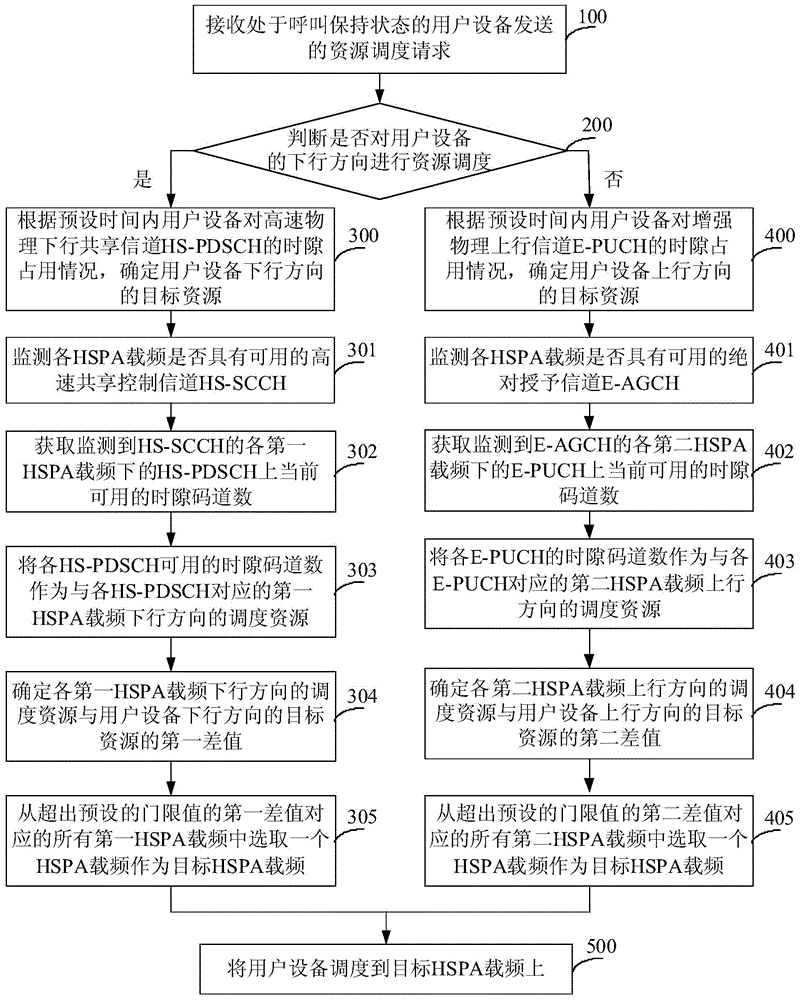HSPA carrier frequency scheduling method and device
A scheduling method and technology of a scheduling device, applied in the field of communication, can solve the problem of low utilization rate of HSPA carrier frequency resources, and achieve the effects of improving resource utilization rate, realizing load balancing, and overcoming low utilization rate
- Summary
- Abstract
- Description
- Claims
- Application Information
AI Technical Summary
Problems solved by technology
Method used
Image
Examples
Embodiment 1
[0030] figure 1 It is a schematic diagram of an HSPA carrier frequency scheduling method provided by an embodiment of the present invention. In this embodiment, the subject of execution of the method may be a network element on the network side. Such as figure 1 As shown, the scheduling method of the HSPA carrier frequency includes the following steps:
[0031] 101. Receive a resource scheduling request sent by a user equipment in a call hold state.
[0032] In this embodiment, before step 101, it further includes: when the user equipment initially accesses the HSPA carrier frequency, the network element receives an access request sent by the user equipment for requesting access to the HSPA carrier frequency. The network element schedules the user equipment to the HSPA carrier frequency with the lowest load among the HSPA carrier frequencies, so that the user equipment initiates a call service on the HSPA carrier frequency.
[0033] When the currently required resources of...
Embodiment 2
[0047] figure 2 It is a schematic diagram of another HSPA carrier frequency scheduling method provided by the embodiment of the present invention. In this embodiment, the subject of execution of the method may be a network element on the network side. Such as figure 2 As shown, the scheduling method of the HSPA carrier frequency includes the following steps:
[0048] Step 100: Receive a resource scheduling request sent by a user equipment in a call hold state.
[0049] When the currently required resources of the user equipment in the call holding state cannot meet the call demand, the network element determines that resource scheduling needs to be performed on the user equipment after receiving the resource scheduling request sent by the user equipment, so as to ensure that the user equipment can be kept Continuation of the call.
[0050]In this embodiment, the resource scheduling request sent by the user equipment is a 4A measurement report. The network element starts ...
Embodiment 3
[0087] image 3 It is a schematic diagram of another HSPA carrier frequency scheduling method provided by the embodiment of the present invention. In this embodiment, the subject of execution of the method may be a network element on the network side. Such as image 3 As shown, the scheduling method of the HSPA carrier frequency includes the following steps:
[0088] Step 301. Receive a resource scheduling request sent by a user equipment in a call hold state.
[0089] Step 302, judging whether to perform resource scheduling for the downlink direction of the user equipment.
[0090] For steps 301 to 302, reference may be made to steps 100 to 200 in the foregoing embodiments. I won't repeat them here. Wherein, if the judgment result of step 302 is yes, step 303 is executed.
[0091] Step 303: Determine the target resources of the user equipment in the downlink direction according to the time slot occupancy of the HS-PDSCH by the user equipment within a preset time period....
PUM
 Login to View More
Login to View More Abstract
Description
Claims
Application Information
 Login to View More
Login to View More - R&D Engineer
- R&D Manager
- IP Professional
- Industry Leading Data Capabilities
- Powerful AI technology
- Patent DNA Extraction
Browse by: Latest US Patents, China's latest patents, Technical Efficacy Thesaurus, Application Domain, Technology Topic, Popular Technical Reports.
© 2024 PatSnap. All rights reserved.Legal|Privacy policy|Modern Slavery Act Transparency Statement|Sitemap|About US| Contact US: help@patsnap.com










